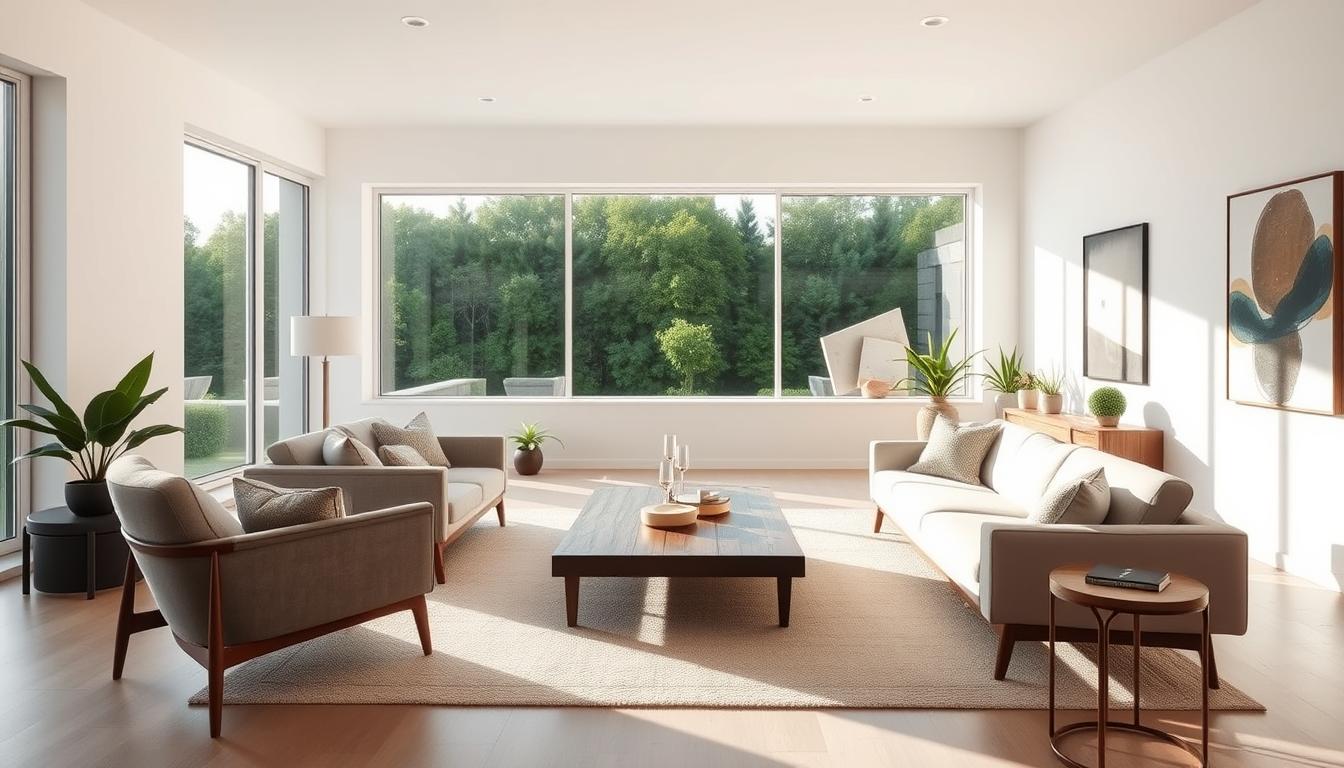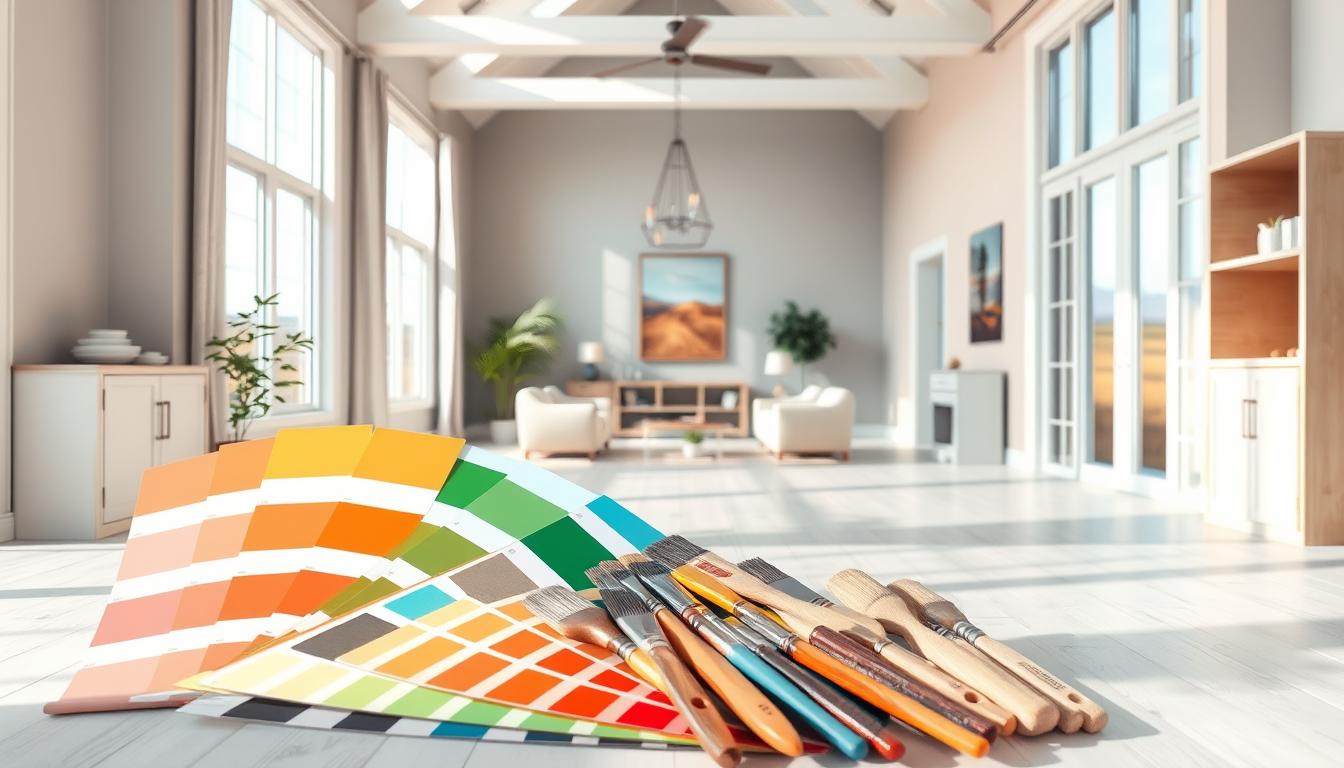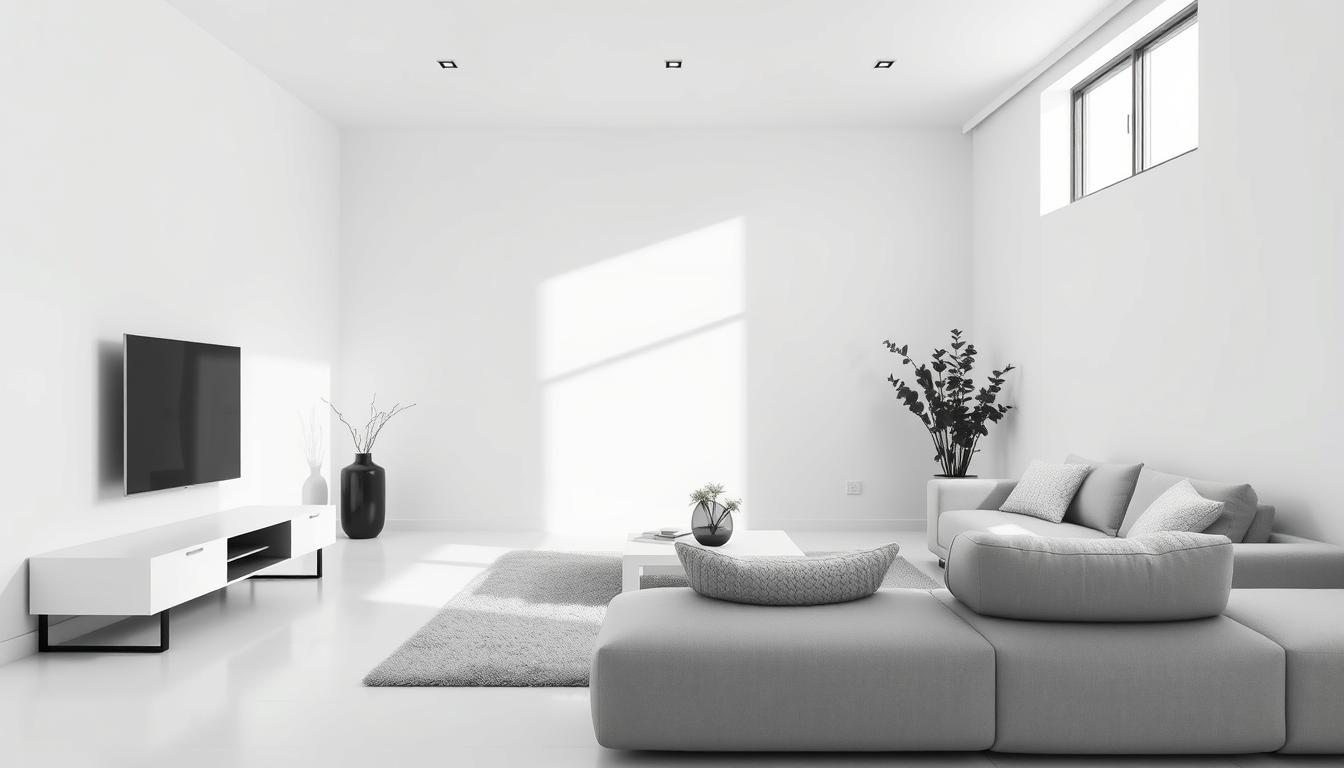Did you know a well-designed home decor can boost your property’s value by up to 10%? This shows how crucial it is to spend time and effort on making your living space beautiful and useful.
We think every home should show off its owner’s style. That’s why we’re eager to share our top interior design tips to improve your homes interior.
This guide aims to give you the tools to update and enhance your living areas. Make them more stunning and practical.
Key Takeaways
- Discover expert tips to enhance your home’s aesthetic appeal
- Learn how to create a functional and comfortable living space
- Explore the latest trends in home decor and interior design
- Understand how to increase your property’s value with effective design
- Get inspired to reflect your personal style in your home’s design
Understanding the Basics of Home Interior Design
To make your home both beautiful and functional, you need to know the basics of interior design. A well-designed home is more than just pretty. It’s a space that’s comfortable and meets the needs of its people.
The Importance of Functionality
Functionality is key in modern interiors. It means your home looks good and works well for you. Think about what each room is for and how it will be used. For example, a home office needs good lighting and comfy furniture for working.
It’s important to find a balance between looks and use. This balance makes contemporary homes both stylish and practical.
Creating a Cohesive Color Palette
Choosing the right colors is a big part of interior decorating. The colors you pick can change how your home feels. The right colors can make your home feel bigger, cozier, or more welcoming.
Use the 60-30-10 rule to pick colors: 60% of a main color, 30% of a secondary color, and 10% of an accent color. This helps your colors work well together.
Choosing the Right Furniture Layout
The way you arrange your furniture is crucial for both looks and use. It’s not just about where you put things. It’s about making the space feel open and easy to move around.
Think about the room’s purpose and how people will move through it. For example, in a living room, arrange seats for talking. In a bedroom, focus on making it calm.
By focusing on these details and using interior decorating tips from experts, you can make a home that’s both beautiful and useful.
Trends in Home Interior Design for 2023
As we enter 2023, home interior design is buzzing with new trends. These trends mix old styles with modern tech and green practices.
Popular Color Schemes
2023 brings new color schemes that brighten up any room. Some top colors include:
- Soft pastels for a calming feel
- Rich jewel tones for a touch of luxury
- Neutral shades for their flexibility
Innovative Materials and Textures
Using new materials and textures is a big trend. We’re seeing more of:
- Sustainable materials like bamboo and recycled wood
- Advanced textiles that are both stylish and practical
Integrating Technology
Adding tech to homes is key in 2023. Ways to do this include:
- Smart home systems for easy control of lights, temperature, and security
- Innovative furniture with built-in charging and wireless features
| Trend | Description | Benefits |
|---|---|---|
| Popular Color Schemes | Soft pastels, rich jewel tones, neutral shades | Enhances ambiance, adds luxury, versatile |
| Innovative Materials and Textures | Sustainable materials, advanced textiles | Eco-friendly, durable, stylish |
| Integrating Technology | Smart home systems, innovative furniture | Convenience, efficiency, modernity |
Essentials of a Comfortable Living Space
A comfortable living space makes you feel relaxed and at home. It’s all about design choices and personal touches. These should reflect your style and preferences.
Designing a cozy space involves several key elements. Cozy textiles, the right lighting, and indoor plants are crucial. Each element adds to the space’s ambiance and comfort.
Selecting Cozy Textiles
Textiles are key in home decor, adding comfort and style. Soft fabrics like velvet, linen, and cotton are great for upholstery and drapery. They bring warmth and texture to a room.
Think about your home’s color palette and style when picking textiles. For example, a minimalist space might need simple, monochromatic fabrics. An eclectic space can have a mix of patterns and textures.
| Textile Type | Characteristics | Best Use |
|---|---|---|
| Velvet | Soft, luxurious, rich texture | Upholstery, accent pillows |
| Linen | Natural, breathable, textured | Drapery, upholstery |
| Cotton | Versatile, durable, easy to clean | Upholstery, bedding, drapery |
Lighting Techniques for Ambiance
Lighting is vital for a cozy and inviting atmosphere. Layered lighting uses different light sources for the perfect ambiance. This includes overhead lights, table lamps, and floor lamps.
The mood of a room changes with lighting. Warm white lights create a cozy feel. Cool white lights make a space feel modern and energized.
The Role of Indoor Plants
Indoor plants are more than decor. They purify the air, reduce stress, and boost mood. They’re good for your health and well-being.
Choose indoor plants based on lighting, care needs, and personal taste. Snake plants, spider plants, and ZZ plants are good choices for beginners.
- Snake plants: Thrive in low light.
- Spider plants: Easy to care for and purify the air.
- ZZ plants: Low maintenance and adaptable to different lighting.
By adding cozy textiles, smart lighting, and indoor plants, you create a space that’s beautiful, comfortable, and inviting.
Maximizing Small Spaces
Creating a spacious feel in small homes is more than decluttering. It’s about making smart design choices. We’ll look at how to use your home’s space well with effective strategies.
Smart Storage Solutions
Storage is a big challenge in small spaces. Efficient storage solutions can really help. Think about using:
- Vertical shelving units to make the most of wall space
- Under-bed storage for bedrooms
- Hidden compartments in furniture
| Storage Solution | Benefits |
|---|---|
| Vertical Shelving | Maximizes wall space, keeps floors clear |
| Under-bed Storage | Uses dead space, keeps bedrooms tidy |
| Hidden Compartments | Hides clutter, adds function to furniture |
Multi-Functional Furniture
Multi-functional furniture is a big help for small spaces. It does more than one thing, so you don’t need many pieces.
Examples include:
- Sofa beds for guests
- Ottomans with storage
- Extendable dining tables
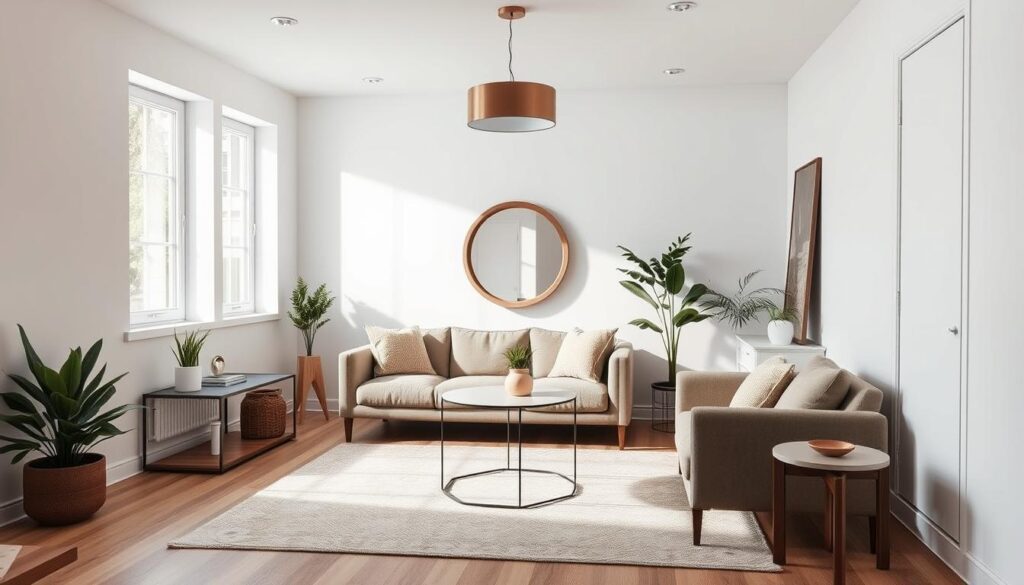
Open Concept Living
Choosing an open concept living layout can make your home feel bigger. By taking down walls, you get a flow and continuity.
Benefits include:
- More natural light
- Better social interaction
- A more spacious feel
By using these strategies, we can make small homes efficient, comfortable, and stylish.
Personalizing Your Homes Interior
Personalizing your home’s interior is a journey of self-expression. It’s about creating a space that looks beautiful and tells your story. By adding elements that show your personality, interests, and experiences, you can make your house a home.
Infusing Your Personality
One of the best ways to make your home unique is by adding your personality. You can do this in many ways, such as:
- Displaying personal items like family photos, heirlooms, or collectibles.
- Incorporating your favorite colors into the decor.
- Showcasing your hobbies or interests through decorative pieces.
For more ideas on how to stylishly incorporate these elements, check out our top 10 interior home decor ideas for a stylish space.
Art and Decor Choices
Art and decor choices are key to personalizing your home. They add character, create focal points, and spark conversations. When picking art and decor, think about:
- Choosing pieces that resonate with your personal style.
- Mixing different textures and materials to add depth.
- Creating a gallery wall featuring a collection of your favorite pieces.
By carefully choosing your art and decor, you can make a space that feels truly yours.
Family Heirlooms and Their Place
Family heirlooms can add a personal touch to your home. They often carry sentimental value and connect you to your heritage. When adding family heirlooms to your decor, consider:
- Displaying them prominently in a place of honor.
- Using them as a starting point for a themed room or decor.
- Restoring or conserving them to preserve their integrity.
By adding these personal elements, you can create a home that is stylish and rich in history and meaning.
The Importance of Lighting in Interior Design
Lighting is key in interior design, making spaces beautiful and functional. It can change a room’s feel, making it feel bigger, cozier, or more luxurious. This depends on what you want to achieve.
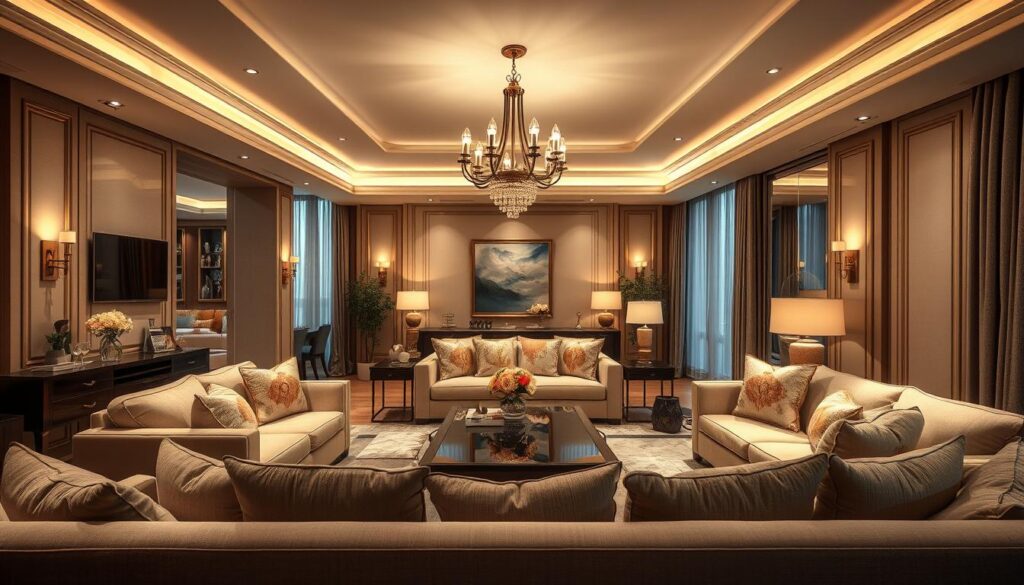
When designing your home’s lighting, think about different aspects for a welcoming atmosphere. We’ll explore layering light sources, enhancing natural light, and adjusting lighting with the seasons.
Layering Different Light Sources
Layering light sources creates a balanced and appealing lighting scheme. This means using ambient, task, and accent lighting together. Each type serves a different purpose.
- Ambient Lighting: Lights up the room, making it easy to move around.
- Task Lighting: Focuses on areas for tasks like reading or cooking.
- Accent Lighting: Highlights special features or artwork, adding depth.
This technique makes your home decor dynamic and engaging, enhancing luxury living spaces.
Natural Light: Strategies for Enhancement
Natural light is essential in interior design, boosting physical and mental health. To get the most out of it, try these strategies:
- Minimize Window Treatments: Open curtains and blinds during the day to let light in.
- Use Mirrors: Place mirrors by windows to reflect light and spread it around the room.
- Select Light Colors: Use light paints and finishes to reflect light and brighten the space.
Improving natural light enhances your home’s ambiance and supports a sustainable, energy-efficient design.
Seasonal Lighting Adjustments
Lighting needs to change with the seasons to keep your home cozy and inviting all year.
- Winter: Use warmer, cozier lighting to fight off cold and darkness.
- Summer: Choose brighter, cooler lighting to match longer days and warmer weather.
Adjusting your lighting with the seasons makes your home decor dynamic and responsive to the outside world.
Creating a Welcoming Entryway
The entryway of your home is more than just a passageway. It’s a preview of the style and warmth that awaits inside.
As the first point of contact for visitors, the entryway plays a crucial role. It sets the tone for the rest of your homes interior. A well-designed entryway can make a lasting impression, blending functionality with personal style.
Key Elements for First Impressions
To create a welcoming entryway, consider the key elements. These include a statement piece of furniture, such as a console table or a bench. It can also serve as a storage unit.
Lighting is another crucial aspect. A stylish chandelier or a pair of sconces can add warmth and elegance. This makes the space feel more inviting.
Practical Storage Ideas
Practicality is just as important as aesthetics in an entryway. Incorporating storage solutions like hooks for hanging coats, a shoe rack, or a storage ottoman can keep the area clutter-free.
- Use a console table with drawers for storing keys, mail, and other essentials.
- Install hooks or a pegboard on the wall for hanging jackets, bags, or accessories.
- Consider a bench with storage underneath for shoes or seasonal items.
Adding Decorative Touches
To make your entryway truly special, add decorative touches that reflect your personal style. This could include a piece of art, a mirror, or a decorative vase.
For a modern interiors look, consider using sleek, minimalist decor. For a more traditional feel, opt for classic pieces with intricate details.
Incorporating Sustainable Design Practices
Sustainable design is now essential in home interior ideas. We need to reduce waste and make our homes healthier. This is key for our planet.
Eco-Friendly Materials
Using eco-friendly materials is a big part of sustainable design. This means choosing items that are recycled, recyclable, or sustainably sourced. For example, reclaimed wood for furniture or flooring is great. It adds character and saves new lumber.
Benefits of Eco-Friendly Materials:
- Less harm to the environment
- Better air inside your home
- Unique and beautiful look
William McDonough, a famous architect, said, “Design is a signal of intention.” By picking eco-friendly materials, we show we care about the planet.
“The buildings and the spaces we create show our values and dreams. Sustainable design is more than being green. It’s about making spaces that are healthy, beautiful, and inspiring.”
Energy Efficiency Considerations
Energy efficiency is vital in sustainable design. It’s not just about using efficient appliances. The home’s design matters too. For instance, using more natural light can cut down on artificial lighting needs.
Here are some ways to boost energy efficiency:
- Choose LED lighting
- Place windows for the best natural light
- Get energy-saving HVAC systems
Biophilic Design Principles
Biophilic design, which brings nature into buildings, is becoming more popular. This can be indoor plants or living walls.
Biophilic design offers many benefits:
| Benefit | Description |
|---|---|
| Improved Air Quality | Indoor plants clean the air |
| Enhanced Well-being | Nature boosts mood and productivity |
| Aesthetic Appeal | Natural elements make spaces beautiful |
By using eco-friendly materials, focusing on energy efficiency, and applying biophilic design, we can make homes that are stunning, sustainable, and healthy.
Designing Functional Outdoor Spaces
Outdoor spaces are like an extra room in our homes. They offer places for relaxation and fun. By designing them well, we can make luxury living spaces that feel like part of our homes.
There are many things to think about when improving our outdoor areas. We want them to be both pretty and useful.
Creating Comfortable Patios
A cozy patio is the core of any outdoor area. We need to pick furniture and decor that’s good for the weather but still comfy and stylish.
Think about using soft outdoor sofas and chairs. Also, get coffee tables and dining sets made for the outdoors. Adding outdoor rugs and pillows can make the space look and feel better.
The Role of Landscaping
Landscaping is key in making outdoor spaces work well. It makes the area look good and creates a calm, private spot.
Using different plants, trees, and flowers can make the space feel natural and match our stylish interiors. Landscaping can also help set up different areas, like places to eat or relax.
Outdoor Lighting Ideas
Lighting is important for using our outdoor spaces at night. It makes the area safe and adds to the feel of the place.
Good lighting ideas include solar lights, string lights, and lights for paths. They light up the area and make it look nice, turning our outdoor spaces into luxury living spaces.
With careful planning, we can make our outdoor areas great. We can have comfy patios, beautiful landscaping, and good lighting. This way, we can enjoy stylish interiors that go beyond our homes.
Creating a Stylish Home Office
Interior design has evolved, making a stylish home office key in modern homes. With more people working from home, it’s important to have a space that looks good and works well.
A good home office boosts our productivity and work satisfaction. To make this happen, we must focus on a few important areas.
Ergonomics and Productivity
Ergonomics is crucial for a comfy and efficient workspace. A good chair and a big desk help us stay focused. Here are some must-haves for ergonomics:
- A comfortable, adjustable chair with proper lumbar support
- A spacious desk that meets our work needs
- Proper lighting to reduce eye strain
Personalizing Your Workspace
Making our home office personal is key. Adding our own touches, like art or photos, makes the space feel more like us. This makes our workspace welcoming and inspiring.
Here are some ways to personalize our home office:
- Adding a statement piece of art or sculpture
- Incorporating plants or a living wall
- Displaying personal mementos or family photos
Choosing Suitable Technology
Technology keeps getting better, so we need the right tools for our home office. This means a reliable computer, a good printer, and a comfy headset.
Here’s a look at some popular tech options for home offices:
| Technology | Features | Price Range |
|---|---|---|
| Laptop | Portability, long battery life | $500-$2000 |
| Desktop Computer | High processing power, customization options | $800-$3000 |
| Printer | High-quality printing, wireless connectivity | $100-$500 |
By picking the right tech and adding ergonomic and personal touches, we can make a home office that’s both stylish and practical.
Budget-Friendly Interior Design Tips
Creating a beautiful home doesn’t have to cost a lot. You can make your home stunning without spending too much. We’ll share some tips to help you decorate your home on a budget.
Thrift stores and online marketplaces are full of unique finds. You can find great deals on items that can be fixed up to match your style. For example, an old door can become a coffee table or a headboard. Check out Satori Loka’s top 10 home interior for more ideas on using old items.
Smart Shopping and DIY Projects
When you’re on a tight budget, focus on the most important things. Look for a comfy sofa or a standout light fixture. Waiting for sales can also save you money. Try DIY projects like painting or upcycling to add your personal touch.
By using these budget-friendly tips, you can make your home stylish and welcoming. With a bit of creativity, you can turn your dream home into reality.

